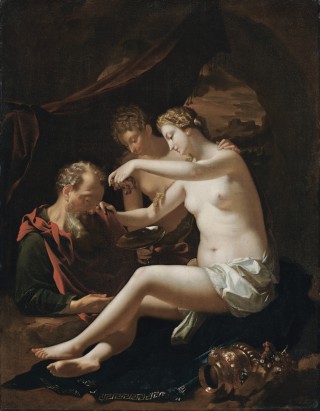Lot and His Daughters
- Date
- after 1694
- Object type
- painting
- Technique
- oil
- Material
- wood
- Dimensions
- 40,5 x 31,7 cm
- Acquisition date
- 1783
- Location
- The Palace on the Isle - Picture Gallery, ground floor
- Marks and inscriptions
- red number 49 of the Stanisław August collection, bottom right (heavily abrased)
- Place of Origin
- Rotterdam (Netherlands)
- Owner
- The Royal Łazienki
- Museum number
- ŁKr 934
Genesis 19: 33–35. …
The original composition, signed and dated Adrnvwerff fec. 1694, a gift of the Elector Palatine, Johann Wilhelm II, for August II (Wettin), was until 1945 in the Gemäldegalerie Alte Meister in Dresden, and was lost during World War II … . The Łazienki picture is a faithful, good quality copy. According to Barbara Gaehtgens— who admitted she only knew the painting from a photograph— it is the work of the master’s studio. …
Van der Werff, one of the last representatives of the ‘fine’ painters (fijnschilders), combined the technique of the Leiden school—smooth texture and meticulous detail—with the classic aesthetics of the turn of the 17th and 18th centuries. In the refined, elegant design of the figures in his mythological, biblical and historical paintings, we can find not only inspiration, but also direct ‘quotes’ from famous ancient sculptures, or from the paintings of Raphael, Domenichino and Poussin, which the painter drew upon via 16th- and 17th-century Italian engraved reproductions, a large collection of which were owned by Nicolaes Anthonis Flinck, the legal guardian of the artist’s wife.
Van der Werff’s Lot and His Daughters does not contain direct borrowings of this kind; here we are dealing with another type of practice—the use of the same motif in several different works. The same seated young woman, raising her hand, shown sideways (one of Lot’s daughters in the Dresden and Łazienki paintings) appears as Delilah in the painting in the Staatliches Museum in Schwerin … and Bethsheba in a painting once in the Steengracht in The Hague … .
The original 18th-century gilded frame, commissioned by Stanisław August, has survived. [D. Juszczak, H. Małachowicz, The Stanisław August Collection of Paintings at the Royal Łazienki. Catalogue, Royal Łazienki Museum, Warsaw 2016, no. 116, pp. 423–425.]



